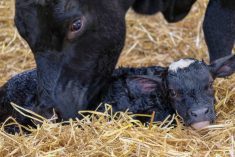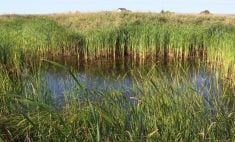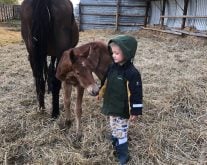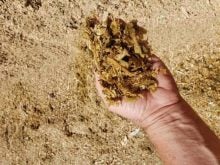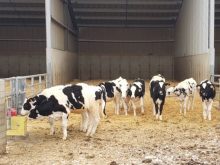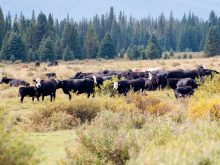High-producing dairy cows always need a good level of effective forage fibre in a well-balanced lactation diet that not only supports good milk and milk fat production, but promotes good cow health and digestion.
Anytime I walk into a dairy barn, I take a minute to watch the cows resting in their stalls. If most are actively chewing their cud, I am confident their diet has enough effective forage fibre.
Unlike energy and protein, fibre is not a true nutrient for dairy cows, but they require it in their diet. Its job is to maintain a healthy population of rumen microbes, which in turn drives feed fermentation and gut mobility.
Read Also

Harvest wraps up and fall work begins
At the Eppich famly ranch in western Saskatchewan, the fall harvest was successful with few breakdowns, cows and calves have been sorted and a new tractor has arrived
Rumination — cud-chewing — is a vital part of this natural process because it helps keep the cow’s digestive system in good working order. Lack of cud-chewing may underlie several associated problems due to low dietary fibre — reduced feed intake, poor feed digestion, subclinical rumen acidosis (SARA), feet and leg problems, butterfat depression and ultimately, poor milk production.
By definition, “effective” forage fibre stimulates the rumen into regurgitating cuds back into the cow’s mouth, which she chews into smaller pieces and swallows again. Such repetitive rumination also produces large volumes of saliva which is rich in sodium bicarbonate that buffers volatile fatty acids produced from feed carbohydrates. It’s estimated that an individual cow can produce about 300 to 400 litres of saliva per day, which maintains a normal pH of 6.0 to 6.5 in a healthy rumen, which is essential for good milk and butterfat production in the udder.
The most common recommendation for providing enough effective fibre in a dairy diet is to provide 28 per cent NDF with 75 per cent of this NDF coming from forage sources. Forage choppers should be set at a forage cut length of 0.5 – 1.0 inch to allow about 15 per cent of 1.5-inch dietary forage particles to pass through. This is thought to create a good rumen mat, essential for efficient feed fermentation.
NDF – measure of fibre
For example, NDF is a measure of all the fibre content in forages — a sum of cellulose, hemicellulose and lignin derived from cell walls of plants. Bulkiness of a forage is positively correlated to its NDF value, which is understandably negatively correlated with feed intake of dairy cows. In contrast, ADF measures cellulose and lignin content only. Animal trials show that increasing forage ADF decreases the amount and rate of fibre digestion.
Of these fibre fractions, quantative research shows that existing forage hemicellulose is digested almost immediately by forage-fermenting microbes at a steady rate and is easily broken down by chemical hydrolysis. The cellulose fraction, which often makes up about 30 per cent of dairy forages, takes a lot longer to digest — up to three hours in-vitro post-introduction and then lost at a steady rate of digestion. Lignin on the other hand is indigestible, and as the forage matures, will “lignify” mainly the cellulose fraction.
Such valuable fibre information gives me some insight as to how many types of forage will be digested in the dairy cow. I can use it to solve some complex dietary issues that come up on occasion. For example, I worked on a dairy diet for a 200-head lactation dairy barn which had a high proportion of early-lactation dairy cows that came down with ketosis within a week of entering the milk line.
In reviewing their current lactation diet, it was comprised of two-thirds alfalfa-haylage and one-third corn silage in its forage base. The total NFC was 37.5 per cent, starch level was 22.5 per cent, and enough forage fibre was fed (22 per cent eNDF). I then reversed the amounts of forage fed; two-thirds corn silage and one-third haylage, in order to take advantage of the higher digestible hemicellulose amounts found in corn silage. As a result, the ketosis issue gradually disappeared. Milk production and milk fat content were maintained.
I can’t say for certain that solving all dietary dairy issues will be simply due to the types of forage fibre and how they are fermented. I had a similar ketotic situation in which I took out barley silage and replaced it with all-corn silage, both with similar NDF profiles. And ketosis disappeared too. All I can be sure of is that all effective forage fibre requirements were met in both situations in order to promote good milk/milk fat production in healthy lactating dairy cows.




